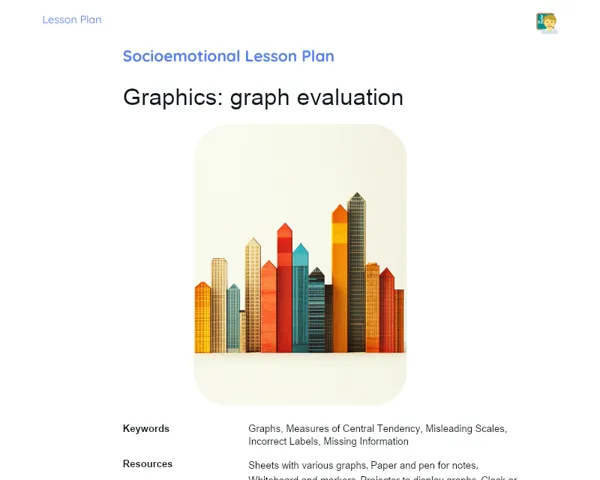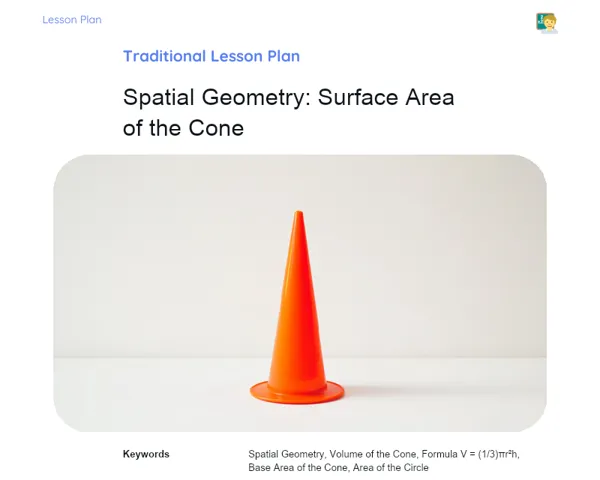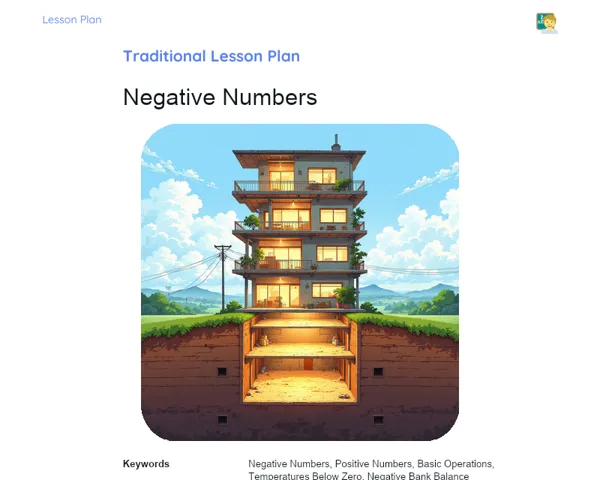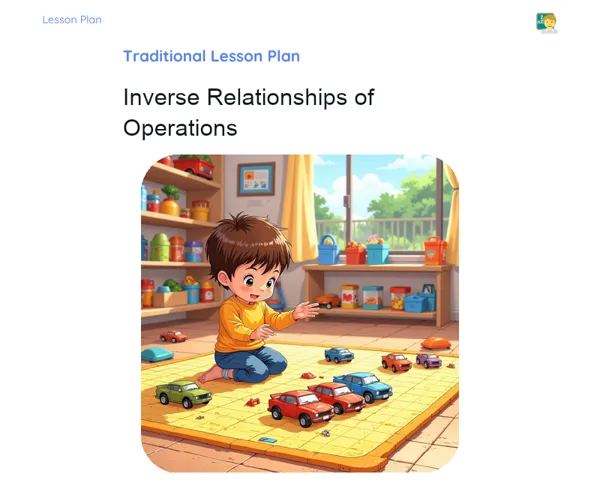Lesson Plan | Lesson Plan Tradisional | Analytic Geometry: Equation of a Line
| Keywords | Analytic Geometry, Line Equation, Coefficients, Slope, Intercept, General Form, Slope-Intercept Form, Cartesian Plane, Practical Examples, Equation Conversion |
| Resources | Whiteboard, Markers, Projector, Presentation Slides, Notebook for notes, Scientific Calculator, Ruler, Printed Cartesian Plane Graphs |
Objectives
Duration: (10 - 15 minutes)
The aim of this stage is to give learners a clear idea of what they will learn during the lesson. By understanding the main objectives, learners can focus their attention and efforts on the most important concepts, making it easier to grasp and remember the content about the equation of a line in analytic geometry.
Objectives Utama:
1. Recognise that the equation of a line is given by the formula ax + by + c = 0.
2. Identify the coefficients a, b, and c in the equation of a line.
3. Understand the relationship between the coefficients and the slope/direction of the line.
Introduction
Duration: (10 - 15 minutes)
🔖 Purpose: This stage aims to set the context of the lesson, showing the relevance and practical application of the content that will be discussed. By linking the concept of the line equation to everyday situations and different areas of knowledge, the goal is to ignite learners' interest and curiosity, providing a more engaging and meaningful learning experience.
Did you know?
🔍 Curiosity: Did you know that the equation of the line is extensively used in computer graphics programming? For instance, in video games, the depiction of three-dimensional environments often starts with defining lines and planes. Furthermore, the equation of a line plays a crucial role in trend analysis on financial charts, aiding investors in making informed decisions based on seen patterns.
Contextualization
📚 Context: Begin the lesson by explaining that Analytic Geometry is a part of mathematics that blends algebra and geometry to solve problems in a more visual and intuitive manner. Point out that the equation of the line is a core concept that helps us describe the position and slope of lines within the Cartesian plane, serving as an essential tool across fields such as physics, engineering, and economics.
Concepts
Duration: (60 - 70 minutes)
🏫 Purpose: This stage aims to deepen learners' understanding of the equation of a line, enabling them to identify and interpret its coefficients, and understand how this equation relates to the graph of the line in the Cartesian plane. By working through practical examples and transforming between different forms of the line equation, students reinforce their theoretical understanding and develop essential practical skills in analytic geometry.
Relevant Topics
1. 📑 Definition of the General Equation of a Line: Explain that the line equation in its general form is expressed as ax + by + c = 0, where a, b, and c are real coefficients. Emphasise that 'a' and 'b' cannot both be zero, as this would not represent a proper line.
2. 🖊️ Identifying the Coefficients: Detail the process of identifying the coefficients a, b, and c in the equation of a line. For example, for the equation 2x - 3y + 6 = 0, a = 2, b = -3, and c = 6.
3. 📊 Graphical Interpretation: Show how the equation of the line relates to its graph on the Cartesian plane. Demonstrate how to find the slope of the line (m = -a/b) and the y-intercept (when x = 0).
4. 📈 Slope-Intercept Form of the Line Equation: Present the slope-intercept form of the line equation y = mx + n, where m is the slope and n is the y-intercept. Illustrate how to change the general equation ax + by + c = 0 into this form.
5. 📝 Practical Examples: Solve practical examples of line equations. For instance, transform the equation 3x + 4y - 12 = 0 into slope-intercept form and sketch its graph.
6. 🔁 Conversion between Forms: Demonstrate how to convert the line equation from general form to slope-intercept form and vice versa. For example, change 2x - y + 3 = 0 to y = 2x + 3.
To Reinforce Learning
1. Given the line equation 5x - 2y + 10 = 0, identify the coefficients a, b, and c.
2. Transform the line equation 4x + 3y - 12 = 0 into slope-intercept form y = mx + n.
3. Determine the slope and y-intercept for the line with the equation 3x - y + 6 = 0.
Feedback
Duration: (15 - 20 minutes)
💡 Purpose: This stage consolidates the knowledge gained throughout the lesson, enabling learners to review and discuss the questions addressed. By exploring these questions in depth, students can clarify doubts, reinforce concepts, and develop a more practical understanding of the equation of a line in analytic geometry. Promoting active participation through questions and reflections fosters a more engaged and collaborative learning atmosphere.
Diskusi Concepts
1. 📝 Question 1: Given the line equation 5x - 2y + 10 = 0, identify coefficients a, b, and c.
Explain: In the general line equation, ax + by + c = 0, the coefficients can be readily identified. For 5x - 2y + 10 = 0, we see that: a = 5 b = -2 c = 10
Highlight how crucial it is to accurately identify these coefficients for any manipulation or interpretation of the line equation. 2. 📝 Question 2: Convert the line equation 4x + 3y - 12 = 0 into slope-intercept form y = mx + n.
Explain: To convert the general equation to slope-intercept form, we must isolate y:
- 4x + 3y - 12 = 0
- 3y = -4x + 12
- y = -4/3x + 4
Thus, the slope-intercept form is y = -4/3x + 4, where m = -4/3 and n = 4. Stress the importance of performing algebraic manipulation accurately. 3. 📝 Question 3: Determine the slope and the y-intercept of the line whose equation is 3x - y + 6 = 0.
Explain: To find the slope (m) and the y-intercept (n), we can convert this to slope-intercept form:
- 3x - y + 6 = 0
- -y = -3x - 6
- y = 3x + 6
So, the slope m is 3 and the y-intercept n is 6. Highlight that the slope indicates the line's direction while the y-intercept shows where the line crosses this axis.
Engaging Students
1. ❓ Question 1: How can we verify if an equation in the form ax + by + c = 0 truly represents a line? Discuss why a and b cannot both be zero at once. 2. ❓ Question 2: Why is it useful to convert the line equation from general form to slope-intercept form? How does this help with interpreting graphs? 3. ❓ Question 3: How does the slope m of a line aid in determining its graphical behaviour? What does a positive, negative, zero, or undefined slope indicate? 4. ❓ Question 4: Encourage students to think about real-world scenarios where the slope and the y-intercept are critical information. For instance, how might this knowledge be applied in civil engineering or financial analysis?
Conclusion
Duration: (10 - 15 minutes)
The aim of this stage is to summarise and consolidate the key points covered during the lesson, ensuring that learners have a clear and comprehensive understanding of the content. The connection between theory and practice is reinforced to highlight the relevance and applicability of the knowledge gained, promoting a deeper and more lasting learning experience.
Summary
['The line equation in general form is expressed as ax + by + c = 0, where a, b, and c are real coefficients.', 'The coefficients a, b, and c can be directly identified in the line equation.', 'The slope of the line (m) can be calculated as the ratio -a/b.', 'The y-intercept is found when x = 0.', 'The slope-intercept form of the line equation is y = mx + n, where m is the slope and n is the y-intercept.', 'You can convert the equation from general form to slope-intercept form and vice versa.']
Connection
Throughout the lesson, learners were introduced to the theory behind the equation of a line, followed by practical applications through concrete examples. This included identifying coefficients, transforming between equation forms, and graphical interpretations, demonstrating how these concepts are relevant in various fields of study and day-to-day situations.
Theme Relevance
The equation of the line is essential in various fields, including physics, engineering, and economics. A practical example is its use in trend analysis on financial charts, guiding investors in making informed decisions. It's also widely used in graphical programming; for instance, in video games, where representing three-dimensional scenes often starts with defining lines and planes.



